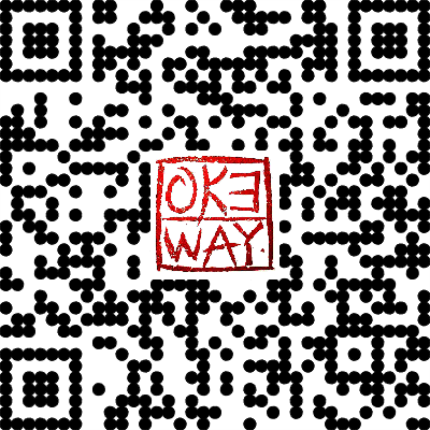1 INTRODUCTION
Organizations decide for the introduction of quality standards because they expect several benefits. Some authors warn about literature being mostly about expected benefits before quality standards introduction, while only some accreditors actually examine the effects of actual standards introduction. The purpose of our survey was to collect information on CARF accreditation benefits in organizations that have already been accredited and to find out how these organizations ensure conformance to CARF standards. Organizations can get maximum 3- year accreditation and afterwards they need to go through accreditation process from the beginning. Moreover, they are expected to operate in conformance to CARF standards and comply with CARF’s policies and procedures in order to maintain accreditation. If new approaches and behaviors are not anchored in the organization’s culture, all the effort is in vain (Kotter 2007, 103). Therefore it is crucial that quality improvement program is continuous and becomes a part of organization’s daily operations (Crosby 1989, 123).
2 RESEARCH QUESTIONS AND METHODS
With the survey we wanted to answer the following questions:
Q1: Which are CARF accreditation benefits?
Q2: How do accredited organizations ensure conformance to CARF standards?
Q3: Do identified CARF accreditation benefits vary between countries or regions?
Q4: Do identified CARF accreditation benefits vary according to the duration of accreditation?
Q5: Do identified CARF accreditation benefits vary among different members of staff?
Q6: Who benefits the most from CARF accreditation survey?
Q7: Do organizations identify CARF accreditation drawbacks?
Q8: Does accreditation process improve daily work?
Q9: Are CARF standards used daily?
Q10: Does CARF become a part of organizational culture?
In order to answer the research questions we drew up a short survey. It had 13 questions in three parts: general information, CARF accreditation benefits, conformance to CARF standards. The link to web survey was sent to approximately 1,500 accredited medical rehabilitation providers in Europe, Canada, USA, South America, Mexico and Middle East.
3 RESULTS
Altogether, we got 259 responses. 8 respondents do not work for a medical rehabilitation provider; therefore we excluded their answers from further analysis.
Table 3.1: The location of respondent's organization
|
Country or region |
N |
% |
|
Europe |
25 |
9.96 % |
|
Canada |
7 |
2.79 % |
|
USA |
215 |
85.66 % |
|
South America |
1 |
0.40 % |
|
Mexico |
1 |
0.40 % |
|
Middle East |
2 |
0.80 % |
|
TOTAL |
251 |
100.00 % |
Table 3.2: The duration of CARF accreditation
|
The duration of CARF accreditation |
N |
% |
|
Less than a year |
11 |
4.38 % |
|
1 year to less than 3 years |
19 |
7.57 % |
|
3 years to less than 6 years |
26 |
10.36 % |
|
6 years or more |
195 |
77.69 % |
|
TOTAL |
251 |
100.00 % |
|
Q1: Which are CARF accreditation benefits? |
Based on relevant literature (Bakan Toplak and Urbajs 2003; Commission on Accreditation of Rehabilitation Facilities 2006), we listed 28 benefits of CARF accreditation. On the scale from 1 (strongly disagree) to 5 (strongly agree) the respondents had to identify CARF accreditation benefits in the organization they work for. 233 respondents answered this question. Among 28 benefits listed the average rating of agreement was higher than 3.5 for 20 benefits, which means that the respondents agree CARF accreditation has the benefits listed in Table 3.3.
Table 3.3: CARF accreditation benefits, with which respondents agree
|
|
CARF accreditation benefits |
Average rating |
|
1 |
Accountability of organization to persons served |
4.38 |
|
2 |
Development of written policies and procedures in all areas |
4.31 |
|
3 |
Raised awareness about quality among staff |
4.30 |
|
4 |
Improved quality of service delivery |
4.25 |
|
5 |
Greater focus on individual needs and personal goals of persons served |
4.24 |
|
6 |
Clarification of processes within the organization |
4.24 |
|
7 |
Positive visibility of organization in public |
4.20 |
|
8 |
Improved communication between staff and persons served/family |
4.05 |
|
9 |
Accountability of organization to community |
4.03 |
|
10 |
Acceptance of responsibility and accountability among managers |
4.01 |
|
11 |
Business improvement |
4.00 |
|
12 |
Developed shared values among staff |
3.97 |
|
13 |
Higher levels of satisfaction among persons served |
3.96 |
|
14 |
Improved risk management |
3.95 |
|
15 |
Networking with other service providers in the industry (peers) |
3.92 |
|
16 |
Improved networking with other staff and departments (interdisciplinary teamwork) |
3.89 |
|
17 |
Ongoing professional growth among personnel |
3.88 |
|
18 |
Improved communication among staff |
3.84 |
|
19 |
Improved communication between staff and managers |
3.78 |
|
20 |
Accountability of organization to employees |
3.66 |
Five highly rated CARF accreditation benefits relate to persons served: accountability of organization to persons served, improved quality of service delivery, improved communication between staff and persons served/family, higher levels of satisfaction among persons served. We can conclude that services are of greater quality and therefore more suitable for persons served due to CARF accreditation.
The other group of highly rated CARF accreditation benefits relate to organizational factors: development of written policies and procedures in all areas (org. structure, daily routines), clarification of processes within the organization, acceptance of responsibility and accountability among managers, business improvement, improved risk management, networking with other service providers in the industry (peers), improved networking with other staff and departments (interdisciplinary teamwork). We can conclude that organizations took advantage of accreditation to make organizational changes. The aim of a quality system is to make processes in organization planned so that every employee is aware about his or her tasks and responsibilities. Improved organizational factors also bring better communication, which was also identified by the respondents. Namely, they have identified improved communication among staff and among staff and managers as benefits of CARF accreditation. One of CARF’s purposes is to provide continuous improvement services. For this purpose standards are revised and updated regularly. Organizations and their staff have to follow these changes so they need to learn and be trained continuously. This is also shown by the results of the survey – the respondents have identified raised awareness about quality among staff and ongoing professional growth among personnel. We can conclude that highly rated benefits related to organizational factors mean that organizations have removed obstacles to changes as advised by Kotter (2007, 101).
138 or 59.22 % of the respondents who answered this question also listed other CARF accreditation benefits. More often mentioned were the following benefits:
- Commitment to ongoing improvement to maintain and improve the quality of services.- CARF accreditation is a tool for marketing of programs and services.
- The quality of services is higher in CARF accredited than in non-accredited organizations. Accreditation therefore means differentiation of services on the market and with other stakeholders.
- Exchange of knowledge among peers at home and abroad.
- Employees in accredited organizations are proud of their work and the quality of services.
- CARF accreditation ensures compliance to the state of the art standards and best practices.
- Higher quality of services and focus on persons served.
- Persons served and other stakeholders being active participants in the processes of development and revision of standards.
- CARF standards help to direct service development projects.- Increased awareness about the importance of keeping records.
- Evaluation of conformance to standards makes employees think differently about the organizational processes.
- CARF standards give you clear directives on how to assure you stay focused on a quality program and services.
- Professionalization of the facility, program, services, and staff.
- Encourages use of data, evidence-based practice, and accountability to persons served/families for outcomes.
- Growth of team spirit and loyalty among employees.
8 of the 28 listed CARF accreditation benefits were rated below 3.5, but higher than 2.5; this means that respondents do not agree nor disagree that CARF accreditation brings benefits listed in Table 3.4.
Table 3.4: CARF accreditation benefits on which respondents do not agree nor disagree
|
|
CARF accreditation benefits |
Average rating |
|
1 |
Accountability of organization to funders |
3.49 |
|
2 |
Higher levels of motivation among employees |
3.37 |
|
3 |
Higher levels of satisfaction among employees |
3.27 |
|
4 |
Higher levels of loyalty among employees |
3.23 |
|
5 |
Greater time efficiency |
2.97 |
|
6 |
Easier funding access |
2.96 |
|
7 |
Insurance premium savings |
2.72 |
|
8 |
Reduction of organization's operational costs |
2.56 |
Three of the lowest rated CARF benefits relate to finances. The results depend on whether organizations are mandated to be accredited or not (MacDonell 2013). Those organizations that are mandated rate financial effects of accreditation higher because they receive more funds. Most of American organizations are not mandated therefore these results are not surprising. Almost 40% of all respondents say that the organization’s operational costs are higher if you are accredited provider because accreditation takes a lot of time and money.
The benefits that accreditation brings to employees (greater motivation, satisfaction, loyalty and time efficiency) also did not receive high rates from respondents. When defining quality authors mostly focus on customers, but it is important to emphasize that the quality of services depends on those delivering them. Employees actually deliver services, deal with problems and they are the ones that make quality system work. Management’s task is to create an environment suitable for transformation of values, beliefs and behaviors, an environment where employees see the personal benefit of offering quality services (Sinclair in Collins 1994, 28). Introduction of quality standards means changes and extra work for employees, and if the environment is not appropriate, employees resist changes. The cause for such results of the survey can be explained by inadequate participation and awareness of employees about quality and changes, which Crosby (1989, 120) considers as one of the most important phase of quality improvement. To conclude, organizations should pay more attention to their employees.
|
Q2: How do accredited organizations ensure conformance to CARF standards? |
11 different ways of ensuring conformance to CARF standards were listed in the survey. On the scale from 1 (strongly disagree) to 5 (strongly agree) the respondents had to rate the ways of ensuring conformance to CARF standards in the organization they work for. 223 respondents answered this question. The average rating of agreement was higher than 3.5 for 8 benefits, which means that respondents agree their organizations use ways for ensuring conformance to standards listed in Table 3.5.
Table 3.5: Ways of ensuring conformance to CARF standards
|
|
Ways of ensuring conformance to CARF standards |
Average rating |
|
1 |
Efforts for improving quality in our organization never end. |
4.53 |
|
2 |
Employees participate in personnel training and education. |
4.46 |
|
3 |
We regularly conduct reviews of knowledge and competencies for all employees. |
4.23 |
|
4 |
We continually test organization’s policies and procedures to verify they are up to date and being followed appropriately. |
4.05 |
|
5 |
Managers are an example for following CARF standards. |
3.96 |
|
6 |
We maintain regular contact with CARF. |
3.72 |
|
7 |
When organization is accredited, enthusiasm over CARF does not decline. |
3.70 |
|
8 |
CARF accreditation team meets regularly. |
3.69 |
Respondents strongly agree that efforts for improving quality in their organization never end, which is in accordance with CARF’s purposes to provide continuous improvement services (Commission on Accreditation of Rehabilitation Facilities 2013, 2), and is also important for institutionalizing the changes brought by accreditation. Both Crosby (1989) and Kotter (2007) emphasize the importance of anchoring changes and of ongoing and day to day efforts for improvement.
The fourth CARF accreditation condition demands form an organization that achieves a three-year accreditation to submit Annual Conformance to Quality Report (Commission on Accreditation of Rehabilitation Facilities 2013, 6). Organization must act in compliance to CARF standards or it can be denied or withdrawn the accreditation award. Therefore it is crucial that knowledge and competencies of employees are regularly reviewed, that employees participate in training and education, and also that policies and procedures are verified. Respondents agree that these are the ways to ensure conformance to standards used in their organizations. Moreover, they are in contact with CARF by attending CARF seminars and conferences and reading newsletters, so the enthusiasm for CARF does not decline when organization gets accredited. Respondents also agree that the managers give an example by following CARF standards and that CARF accreditation team meets regularly.
From 223 respondents who answered this question 18.39% identified other ways of ensuring conformance to standards. More often mentioned were the following ways:
- Organization, policies and documentation are reviewed regularly and reflect conformance to standards.- Attendance at CARF seminars, webinars and conferences.
- Networking, collaboration and benchmarking with other accredited facilities.
- Communication with employees – team meetings, newsletter to staff, etc.
- CARF standards and accreditation are standing agenda items on unit leadership committee meetings.
- Yearly review of the standards’ changes and updating policies and practices as needed.
- We start preparing for CARF survey a year early so we are continually making sure we are in conformance.
- Submitting the Annual Conformance to Quality Report required by CARF.
- We have a surveyor as an employee who informs us of changes to our programs.
- Regular mock surveys of the organization.
- Quality outcome measurement.
3 of the 11 listed ways of ensuring conformance to CARF standards were rated below 3.5, but higher than 2.5, which means that respondents do not agree nor disagree they use ways of ensuring conformance listed in Table 3.6.
Table 3.6: Ways of ensuring conformance to CARF standards on which respondents do not agree nor disagree
|
|
Ways of ensuring conformance to CARF standards |
Average rating |
|
1 |
Employee succession is planned in order to retain knowledge. |
3.43 |
|
2 |
Employees are rewarded for performance in accordance with CARF standards. |
3.05 |
|
3 |
Employees are promoted for performance in accordance with CARF standards. |
2.78 |
There are organizations that drop CARF accreditation. According to MacDonell (2013), one of the reasons for that are personnel changes in organizations where there is one person passionate about CARF, and after this person leaves the organization there is no driving force for CARF anymore. The results of the survey show that respondents do not agree nor disagree that employee succession is planned. They agree even less with the fact that employees are rewarded and promoted for performance in accordance with CARF standards, although these are methods to institutionalize changes (Crosy 1989; Kotter 2007). All three ways of ensuring conformance to standards that are not often used are related to employees. As already mentioned with the previous research question, organization pay more attention to the persons served than to their employees although the latter are the ones who deliver services and on whom the quality of services depends.
Q3: Do identified CARF accreditation benefits vary between countries or regions?
|
|
233 respondents answered the question on CARF accreditation benefits: 204 from USA, 18 from Europe, 7 from Canada, 2 from the Middle East and one from South America and Mexico. Due to small sample only answers from USA and Europe were included into analysis.
To answer the question we did a t-test. As seen from Table 3.7, there are no significant differences in identified CARF benefits between Europe and USA. In average, European respondents strongly agree with the listed benefits than Americans. With t-test we discovered that there are statistically significant differences between USA and Europe (where sig. is lower than 0.05) for five CARF accreditation benefits listed in the survey: clarification of processes within the organization, greater time efficiency, higher levels of loyalty, motivation and satisfaction among employees. It is interesting that four of these benefits relate to employees and that European respondents strongly than American agree that these are CARF benefits.
On the basis of the results we can conclude that CARF accreditation benefits do not vary between Europe and USA. This may be due to the fact that standards are identical for all accredited organizations and are not adjusted for different organizations, regions or countries. Despite its location, the organization aspiring to become accredited must demonstrate compliance to universal standards.
Table 3.7: Agreement with CARF accreditation benefits
|
|
CARF accreditation benefits |
Europe |
USA |
Difference Europe - USA |
sig. (t- test) |
|
N = 18 |
N = 204 |
||||
|
Avg. |
Avg. |
||||
|
1 |
Business improvement |
4.06 |
3.98 |
0.08 |
0.727 |
|
2 |
Improved risk management |
4.28 |
3.89 |
0.39 |
0.114 |
|
3 |
Insurance premium savings |
2.56 |
2.74 |
-0.18 |
0.252 |
|
4 |
Reduction of organization's operational costs |
2.83 |
2.54 |
0.29 |
0.079 |
|
5 |
Easier funding access |
2.89 |
2.97 |
-0.08 |
0.675 |
|
6 |
Positive visibility of organization in public |
4.17 |
4.19 |
-0.02 |
0.884 |
|
7 |
Networking with other service providers in the industry (peers) |
3.61 |
3.96 |
-0.35 |
0.137 |
|
8 |
Improved networking with other staff and departments (Interdisciplinary teamwork) |
4.11 |
3.86 |
0.25 |
0.199 |
|
9 |
Clarification of processes within the organization |
4.61 |
4.19 |
0.42 |
0.003 |
|
10 |
Development of written policies and procedures in all areas (org. structure. daily routines) |
4.50 |
4.26 |
0.24 |
0.087 |
|
11 |
Greater time efficiency |
3.61 |
2.90 |
0.71 |
0.001 |
|
12 |
Developed shared values among staff |
4.06 |
3.96 |
0.10 |
0.547 |
|
13 |
Raised awareness about quality among staff |
4.39 |
4.27 |
0.12 |
0.444 |
|
14 |
Acceptance of responsibility and accountability among managers |
4.06 |
4.00 |
0.06 |
0.713 |
|
15 |
Ongoing professional growth among personnel |
4.06 |
3.86 |
0.20 |
0.174 |
|
16 |
Accountability of organization to funders |
3.61 |
3.45 |
0.17 |
0.360 |
|
17 |
Accountability of organization to employees |
3.72 |
3.63 |
0.09 |
0.604 |
|
18 |
Accountability of organization to persons served |
4.22 |
4.38 |
-0.16 |
0.350 |
|
19 |
Accountability of organization to community |
3.72 |
4.03 |
-0.31 |
0.079 |
|
20 |
Improved quality of service delivery |
4.50 |
4.22 |
0.28 |
0.083 |
|
21 |
Greater focus on individual needs and personal goals of persons served |
4.33 |
4.23 |
0.11 |
0.479 |
|
22 |
Higher levels of loyalty among employees |
3.56 |
3.20 |
0.35 |
0.015 |
|
23 |
Higher levels of motivation among employees |
3.78 |
3.32 |
0.46 |
0.004 |
|
24 |
Higher levels of satisfaction among employees |
3.72 |
3.22 |
0.51 |
0.002 |
|
25 |
Higher levels of satisfaction among persons served |
3.89 |
3.97 |
-0.08 |
0.637 |
|
26 |
Improved communication between staff and persons served/family |
4.00 |
4.03 |
-0.03 |
0.850 |
|
27 |
Improved communication among staff |
3.89 |
3.80 |
0.09 |
0.558 |
|
28 |
Improved communication between staff and managers |
3.89 |
3.75 |
0.14 |
0.350 |
|
|
AVERAGE |
3.88 |
3.74 |
0.14 |
0.210 |
|
Q4: Do identified CARF accreditation benefits vary according to the duration of accreditation? |
For the purposes of analysis we divided 233 responses in two groups: 1 - organizations that have been accredited less than six years and 2 - those accredited six years or more. We did a t-test and the results show that differences between the two groups are only for greater time efficiency (see Table 3.8). Since there are no other statistically significant differences, we can conclude that CARF accreditation benefits are seen immediately and last the entire time of accreditation. The reason for such result may be accreditation conditions set by CARF which require ongoing work in the field of quality.
Table 3.8: Agreement with CARF accreditation benefits in relation to the duration of accreditation
|
|
CARF accreditation benefits |
Accredited less than 6 years |
Accredited 6 years or more |
difference |
sig. (t- test ) |
|
N = 46 |
N = 187 |
||||
|
Avg. |
Avg. |
||||
|
1 |
Business improvement |
4.11 |
3.98 |
0.13 |
0.304 |
|
2 |
Improved risk management |
4.07 |
3.92 |
0.15 |
0.300 |
|
3 |
Insurance premium savings |
2.72 |
2.72 |
0.00 |
0.995 |
|
4 |
Reduction of organization's operational costs |
2.74 |
2.52 |
0.22 |
0.094 |
|
5 |
Easier funding access |
3.15 |
2.91 |
0.24 |
0.120 |
|
6 |
Positive visibility of organization in public |
4.22 |
4.19 |
0.03 |
0.822 |
|
7 |
Networking with other service providers in the industry (peers) |
3.78 |
3.95 |
-0.17 |
0.268 |
|
8 |
Improved networking with other staff and departments (Interdisciplinary teamwork) |
4.02 |
3.86 |
0.16 |
0.233 |
|
9 |
Clarification of processes within the organization |
4.33 |
4.22 |
0.11 |
0.335 |
|
10 |
Development of written policies and procedures in all areas (org. structure. daily routines) |
4,35 |
4.30 |
0.05 |
0.645 |
|
11 |
Greater time efficiency |
3.35 |
2.88 |
0.47 |
0.003 |
|
12 |
Developed shared values among staff |
3.93 |
3.98 |
-0.05 |
0.723 |
|
13 |
Raised awareness about quality among staff |
4.28 |
4.30 |
-0.02 |
0.871 |
|
14 |
Acceptance of responsibility and accountability among managers |
4.00 |
4.02 |
-0.02 |
0.895 |
|
15 |
Ongoing professional growth among personnel |
3.93 |
3.86 |
0.07 |
0.511 |
|
16 |
Accountability of organization to funders |
3.63 |
3.45 |
0.18 |
0.211 |
|
17 |
Accountability of organization to employees |
3.76 |
3.64 |
0.12 |
0.386 |
|
18 |
Accountability of organization to persons served |
4.26 |
4.41 |
-0.15 |
0.284 |
|
19 |
Accountability of organization to community |
3.89 |
4.06 |
-0.17 |
0.270 |
|
20 |
Improved quality of service delivery |
4.33 |
4.24 |
0.09 |
0.421 |
|
21 |
Greater focus on individual needs and personal goals of persons served |
4.35 |
4.22 |
0.13 |
0.245 |
|
22 |
Higher levels of loyalty among employees |
3.28 |
3.22 |
0.06 |
0.594 |
|
23 |
Higher levels of motivation among employees |
3.46 |
3.35 |
0.11 |
0.411 |
|
24 |
Higher levels of satisfaction among employees |
3.39 |
3.25 |
0.14 |
0.255 |
|
25 |
Higher levels of satisfaction among persons served |
3.87 |
3.98 |
-0.11 |
0.374 |
|
26 |
Improved communication between staff and persons served/family |
3.98 |
4.07 |
-0.09 |
0.502 |
|
27 |
Improved communication among staff |
3.72 |
3.87 |
-0.15 |
0.266 |
|
28 |
Improved communication between staff and managers |
3.74 |
3.79 |
-0.05 |
0.714 |
|
|
AVERAGE |
3.81 |
3.76 |
0.05 |
0.524 |
|
Q5: Do identified CARF accreditation benefits vary among different members of staff? |
233 respondents answered the question about work position and also the question on CARF accreditation benefits. More than half of the respondents are managers or CEOs, while “other” mean researcher, psychologist, CARF coordinator and two specialists on quality and accreditation (see Table 3.9).
Table 3.9: Respondents' work positions
|
Work position |
N |
% |
|
CEO |
36 |
15.,45 % |
|
Manager |
121 |
51.93 % |
|
Physician |
9 |
3.86 % |
|
Nurse |
12 |
5.15 % |
|
Therapist |
19 |
8.15 % |
|
Social worker |
3 |
1.29 % |
|
Administrative staff |
28 |
12.02 % |
|
Other |
5 |
2.15 % |
|
TOTAL |
233 |
100.00 % |
For the purposes of analysis we joined work positions into two groups – “managers” (CEOs and managers) and “others” (physicians, nurses, therapists, social workers, administrative staff and other) and did a t-test. The results show that there are statistically significant differences between managers and others for 11 CARF accreditation benefits (see Table 3.10): insurance premium savings, reduction of organization’s operational costs, positive visibility of organization in public, improved networking with other staff and departments, greater time efficiency, ongoing professional growth among personnel, higher levels of motivation and satisfaction among employees, improved communication on all levels. It is interesting that on all these 11 accreditation benefits others agree more than managers and that eight of these benefits relate to employees. In comparison to managers and CEOs, other employees more agree on the benefits CARF accreditation brings. To conclude, there are statistically significant differences among managers and others so we can say that work position affects the perceived effects of CARF standards introduction.
Table 3.10: Agreement with CARF accreditation benefits regarding work position
|
|
CARF accreditation benefits |
managers |
others |
difference |
sig. (t- test) |
|
N = 157 |
N = 76 |
||||
|
Avg. |
Avg. |
||||
|
1 |
Business improvement |
3.98 |
4.05 |
-0.07 |
0.510 |
|
2 |
Improved risk management |
3.89 |
4.07 |
-0.18 |
0.142 |
|
3 |
Insurance premium savings |
2.64 |
2.88 |
-0.24 |
0.032 |
|
4 |
Reduction of organization's operational costs |
2.48 |
2.74 |
-0.26 |
0.023 |
|
5 |
Easier funding access |
2.90 |
3.08 |
-0.18 |
0.186 |
|
6 |
Positive visibility of organization in public |
4.13 |
4.34 |
-0.21 |
0.033 |
|
7 |
Networking with other service providers in the industry (peers) |
3.92 |
3.92 |
0.00 |
0.977 |
|
8 |
Improved networking with other staff and departments (Interdisciplinary teamwork) |
3.79 |
4.09 |
-0.30 |
0.016 |
|
9 |
Clarification of processes within the organization |
4.19 |
4.34 |
-0.15 |
0.153 |
|
10 |
Development of written policies and procedures in all areas (org. structure. daily routines) |
4.29 |
4.36 |
-0.07 |
0.479 |
|
11 |
Greater time efficiency |
2.88 |
3.16 |
-0.28 |
0.030 |
|
12 |
Developed shared values among staff |
3.97 |
3.97 |
0.00 |
0.994 |
|
13 |
Raised awareness about quality among staff |
4.25 |
4.38 |
-0.13 |
0.216 |
|
14 |
Acceptance of responsibility and accountability among managers |
3.96 |
4.12 |
-0.16 |
0.159 |
|
15 |
Ongoing professional growth among personnel |
3.78 |
4.08 |
-0.30 |
0.006 |
|
16 |
Accountability of organization to funders |
3.42 |
3.63 |
-0.21 |
0.089 |
|
17 |
Accountability of organization to employees |
3.62 |
3.75 |
-0.13 |
0.304 |
|
18 |
Accountability of organization to persons served |
4.36 |
4.41 |
-0.05 |
0.694 |
|
19 |
Accountability of organization to community |
3.97 |
4.13 |
-0.16 |
0.199 |
|
20 |
Improved quality of service delivery |
4.24 |
4.28 |
-0.04 |
0.752 |
|
21 |
Greater focus on individual needs and personal goals of persons served |
4.25 |
4.24 |
0.01 |
0.912 |
|
22 |
Higher levels of loyalty among employees |
3.15 |
3.39 |
-0.24 |
0.056 |
|
23 |
Higher levels of motivation among employees |
3.27 |
3.57 |
-0.30 |
0.024 |
|
24 |
Higher levels of satisfaction among employees |
3.18 |
3.47 |
-0.29 |
0.018 |
|
25 |
Higher levels of satisfaction among persons served |
3.94 |
4.01 |
-0.07 |
0.497 |
|
26 |
Improved communication between staff and persons served/family |
3.97 |
4.21 |
-0.24 |
0.042 |
|
27 |
Improved communication among staff |
3.74 |
4.04 |
-0.30 |
0.012 |
|
28 |
Improved communication between staff and managers |
3.68 |
3.97 |
-0.29 |
0.015 |
|
|
AVERAGE |
3.71 |
3.88 |
-0.17 |
0.032 |
|
Q6: Who benefits the most from CARF accreditation survey? |
233 respondents answered the question on who benefits the most from CARF accreditation survey. 77.4 % of the respondents think that persons served and their families benefit the most (see Graph 3.1).
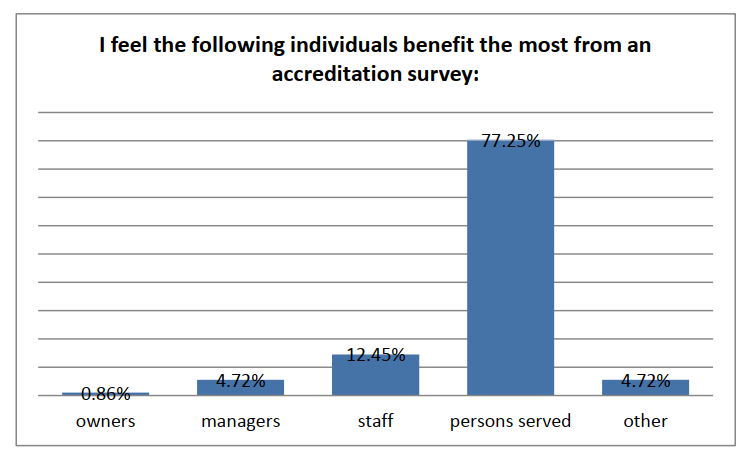
Graph 3.1: Beneficiaries of CARF accreditation
11 or 4.72 % of the respondents chose the answer “others” – 4 of them think that all the listed individuals benefit from the accreditation survey, 4 think that both employees and persons served are the main beneficiaries, one respondent wrote that CARF benefited the most, one wrote it was the community, and one of the respondents is not sure who benefits the most.
Undoubtedly, persons served are the main beneficiaries of CARF accreditation survey. The results are in accordance with CARF’s vision that “CARF serves as a catalyst for improving the quality of life of the persons served” and also with the fact that CARF defines persons served as its moral owners (Commission on Accreditation of Rehabilitation Facilities 2013, 1).
|
Q7: Do organizations identify CARF accreditation drawbacks? |
230 respondents answered the question on CARF accreditation drawbacks. Exactly 50 % of them answered the question with “yes”. 100 or 86,95 % of all respondents who identify drawbacks say that CARF accreditation requires too many resources – time and money. Because of preparations for accreditation survey, additional records or documents required by CARF, and ensuring conformance to standards employees have less time for persons served, or organization has to hire CARF coordinator who only works on accreditation. Moreover, the accreditation itself is also very expensive. Due to CARF accreditation organization’s operational costs are higher, which is confirmed by 4 respondents who wrote that it was difficult to ensure conformance to standards during economic crisis when organizations are forced to cut their expenses. 10 respondents wrote that resources required by accreditation were higher than CARF accreditation benefits. When developing new and reviewing existing standards CARF should pay more attention to the resources required to implement the standard as measured against the benefit gained for persons served says one respondent who also adds that if maintaining accreditation becomes too financially burdensome, organizations will be forced to discontinue optional accreditations. Two respondents emphasized that CARF accreditation had lost the reputation it used to have; one says that their insurers do not even ask about CARF anymore, while the other wrote that their organization also had to undergo a state licensure survey. One person wrote that most payers did not care about nor require CARF; however, he knows that CARF makes them a better organization. Two respondents wrote some standards were repetitive, outdated and even redundant. One person thinks there is no qualitative bonus to being CARF accredited, one says that high quality of care can happen without CARF accreditation and one wrote that satisfaction among persons served and the quality of care decreased with CARF accreditation. Eight respondents say that CARF accreditation is not suitable for smaller organizations.
Three European respondents wrote that standards were not applicable in their organizations. A respondent from Ireland wrote that some translation of USA healthcare model to Irish healthcare system had to take place. Another wrote that some of the mandatory standards were less applicable to national legislation and created a bit of a noise among staff. MacDonell (2013) answered that “organizations have to meet their legal and regulatory requirements and that always supersedes any standard”. British respondent thinks CARF is not yet recognized widely in the UK or to their overseas clients. MacDonell (2013) agrees with that and says this is also the reason to open an office in the UK.
Q8: Does accreditation process improve daily work?
|
|
Respondents had to rate the value of the accreditation process in improving their daily work on a scale from 1 (no value) to 5 (high value). Out of 230 respondents who answered the question 67,8% rated the value with 4 or 5, the average rate is 3.88 (see Table 3.11). We can conclude that CARF accreditation process improves employees’ daily work.
Table 3.11: The value of the accreditation process in improving daily work
|
value |
N |
% |
|
1 – no value |
2 |
0.87 % |
|
2 |
17 |
7.39 % |
|
3 |
55 |
23.91 % |
|
4 |
88 |
38.26 % |
|
5 – high value |
68 |
29.57 % |
|
TOTAL |
230 |
100.00 % |
16 respondents who rated the value with 2 are from USA, one is from Europe. 13 work in organizations that have been accredited over six years. 10 respondents are managers, 3 are administrative staff, 2 are CEOs, and one is a physician and one a social worker.
Both respondents who rated the value of accreditation process in improving daily work with 1 come from USA and are managers in organizations that have been accredited for over six years. One of them says that CARF is the main beneficiary of CARF accreditation because it is a very time consuming process and he questions the value of it, and he thinks CARF has not become a part of organizational culture. The other respondent says CARF accreditation is a great deal of work for little to no return, but on the other hand also thinks CARF has become a part of organizational culture.
|
Q9: Are CARF standards used daily? |
233 respondents answered the question on how often they use CARF standards. 130 or 58.30 % answered they use standards daily, 24.66 % use them weekly and 13 % monthly (see Graph 3.2).
Graph 3.2: Use of CARF standards
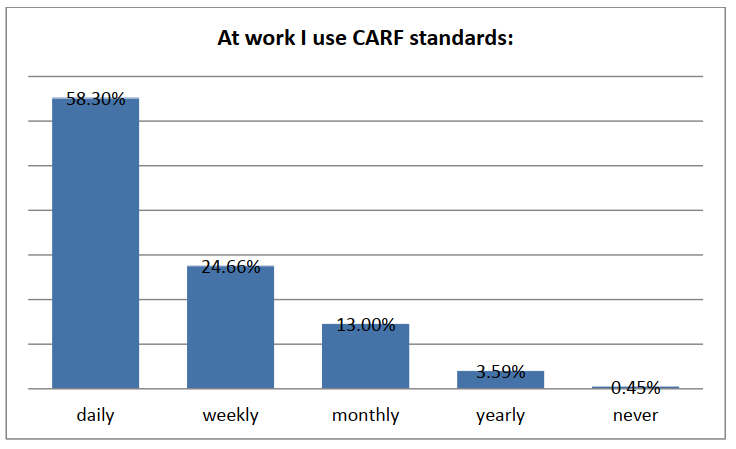
|
|
29 respondents use CARF standards monthly: 16 managers, 6 CEOs, 3 physicians, a therapist, nurse and two persons who work in administration. 26 of them work in organizations that have been accredited for over six years.
8 respondents who use standards yearly come from organizations that have been accredited for more than six years, two of them think CARF has not become a part of organizational culture. 5 respondents are managers, one is CEO, one works in administration, and one is quality manager.
The only respondent who never uses CARF standards is a physician from American organization that has been accredited for the first time more than six years ago. Yet he says CARF has become a part of organizational culture.
To conclude, CARF standards are not used daily or weekly by persons who work in higher positions in organizations that have been accredited for years. MacDonell (2013) says this probably means they have some yearly review of standards and the rest is a part of what they do every day.
|
Q10: Does CARF become a part of organizational culture? |
209 or 93.72 % of respondents answered this question with “yes”, so CARF definitely becomes a part of organizational culture.
Graph 3.3: CARF as a part of organizational culture
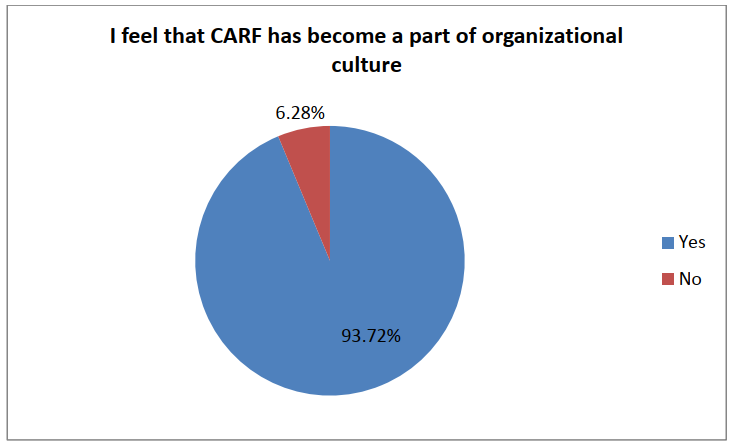
In 14 organizations CARF has not become a part of organizational culture: 11 are from USA, 2 from Europe and one from Canada. It is surprising that these are organizations that have been accredited for longer period: 5 have had accreditation for at least one year, one has it over three years and 8 organizations have been accredited for more than six years.
-
International Research
 瑞典隆德大学:CARF给我们医院带来了医疗质量
瑞典隆德大学医院是北美外第一家通过CARF认证的康复机构,该科室获得了三年认证,也是CARF认证中最高级别的认证。1996年以来,该院就对成人跨学科疼痛管理,综合住院项目,脊髓损伤单科项目和脑损伤住院和门诊项目分别进行了认证。
瑞典隆德大学:CARF给我们医院带来了医疗质量
瑞典隆德大学医院是北美外第一家通过CARF认证的康复机构,该科室获得了三年认证,也是CARF认证中最高级别的认证。1996年以来,该院就对成人跨学科疼痛管理,综合住院项目,脊髓损伤单科项目和脑损伤住院和门诊项目分别进行了认证。 -
CARF News
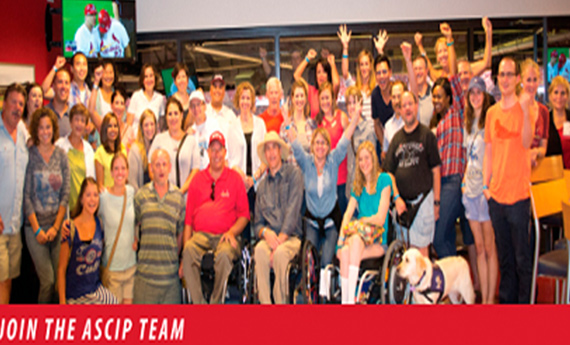 ASCIP joins CARF’s International Advisory Council
April 27, 2016, Tucson, Arizona — The Academy of Spinal Cord Injury Professionals (ASCIP) has accepted a seat on CARF’s International Advisory Council (IAC), bringing added expertise from the field of spinal cord rehabilitation to CARF’s standards development process.CARF Progress in China
ASCIP joins CARF’s International Advisory Council
April 27, 2016, Tucson, Arizona — The Academy of Spinal Cord Injury Professionals (ASCIP) has accepted a seat on CARF’s International Advisory Council (IAC), bringing added expertise from the field of spinal cord rehabilitation to CARF’s standards development process.CARF Progress in China 榕城康复大事记:福建中医药大学附属康复医院迎来CARF认证考察
2016年4月27日-29日,为期三天的CARF认证考察在福建中医药大学附属康复医院如期进行。
榕城康复大事记:福建中医药大学附属康复医院迎来CARF认证考察
2016年4月27日-29日,为期三天的CARF认证考察在福建中医药大学附属康复医院如期进行。








